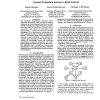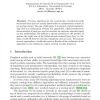122
Voted
CVPR
2012
IEEE
13 years 3 months ago
2012
IEEE
This paper investigates how to parse (segment) facial components from face images which may be partially occluded. We propose a novel face parser, which recasts segmentation of fa...
132
Voted
JMLR
2012
13 years 3 months ago
2012
Motivated by the observation that coarse and fine resolutions of an image reveal different structures in the underlying visual phenomenon, we present a model based on the Deep B...
129
Voted
JMLR
2010
14 years 7 months ago
2010
Deep belief networks are a powerful way to model complex probability distributions. However, it is difficult to learn the structure of a belief network, particularly one with hidd...
113
Voted
AAAI
1990
15 years 2 months ago
1990
The Symbolic Probabilistic Inference (SPI) Algorithm [D'Ambrosio, 19891 provides an efficient framework for resolving general queries on a belief network. It applies the conc...
100
click to vote
WSC
1998
15 years 2 months ago
1998
A method for automatically improving the performance of construction operations was developed by the integration of computer simulation and belief networks. The simulation model i...
132
Voted
IJCAI
1997
15 years 2 months ago
1997
Bayesian belief networks have grown to prominence because they provide compact representations of many domains, and there are algorithms to exploit this compactness. The next step...
PKDD
2000
Springer
15 years 4 months ago
2000
Springer
Previous algoritms for the construction of belief networks structures from data are mainly based either on independence criteria or on scoring metrics. The aim of this paper is to ...
106
Voted
CIKM
1997
Springer
15 years 5 months ago
1997
Springer
This paper presents an efficient algorithm for learning Bayesian belief networks from databases. The algorithm takes a database as input and constructs the belief network structur...
96
Voted
ECSQARU
2001
Springer
15 years 5 months ago
2001
Springer
Abstract. Although we can build a belief network starting from any ordering of its variables, its structure depends heavily on the ordering being selected: the topology of the netw...
116
Voted
AMAI
2004
Springer
15 years 6 months ago
2004
Springer
Learning the parameters (conditional and marginal probabilities) from a data set is a common method of building a belief network. Consider the situation where we have known graph s...





